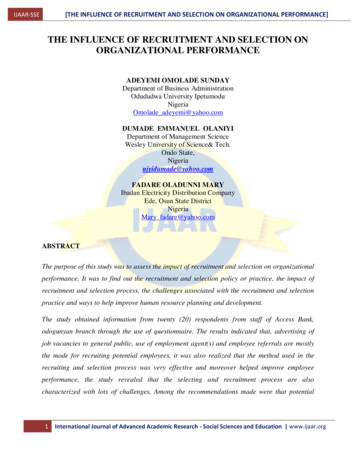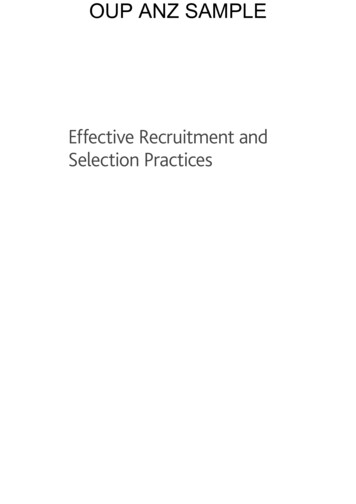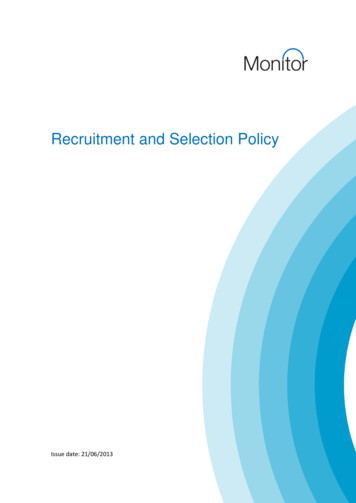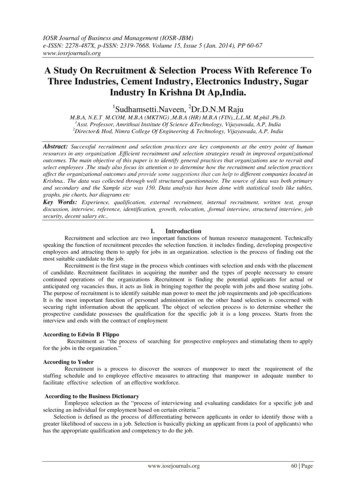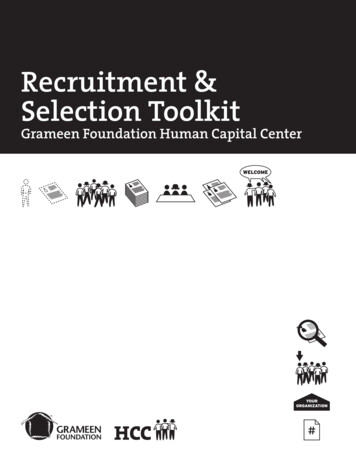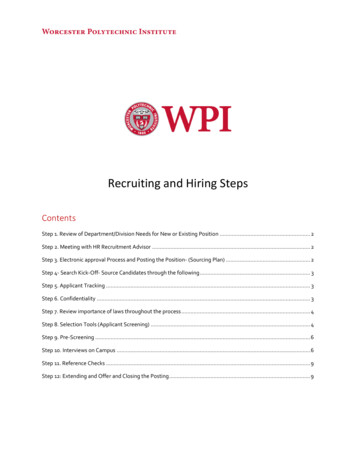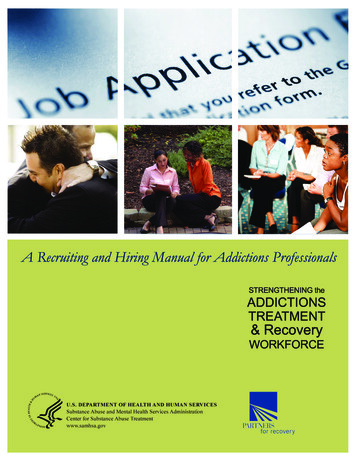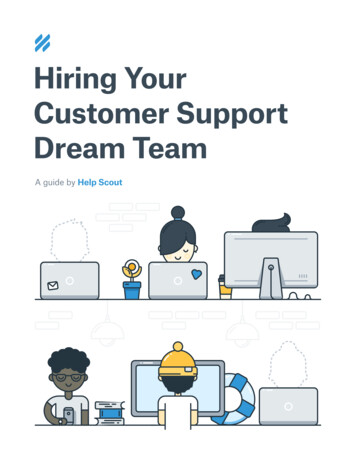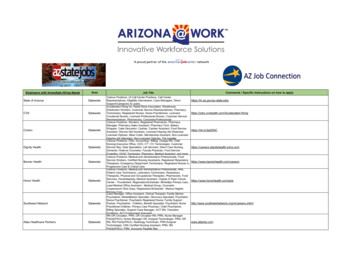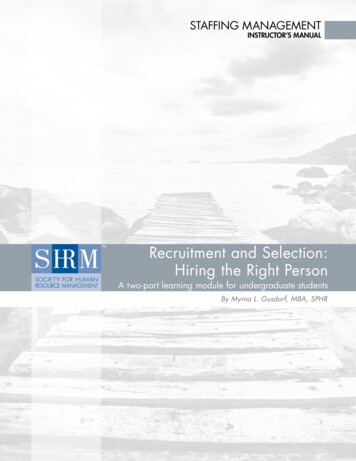
Transcription
Staffing Managementinstructor’s ManualRecruitment and Selection:Hiring the Right PersonA two-part learning module for undergraduate studentsBy Myrna L. Gusdorf, MBA, SPHR
Project TeamAuthor:Myrna Gusdorf, MBA, SPHRSHRM projectcontributors:Bill Schaefer, SPHRNancy A. Woolever, SPHRExternalcontributor:Sharon H. LeonardEditor:Katya Scanlan, copy editorDesign:Blair Wright, senior graphic designer 2008 Society for Human Resource Management. Myrna Gusdorf, MBA, SPHRNote to HR faculty and instructors: SHRM cases and modules are intended for use in HR classrooms atuniversities. Teaching notes are included with each. While our current intent is to make the materials availablewithout charge, we reserve the right to impose charges should we deem it necessary to support the program. However,currently, these resources are available free of charge to all. Please duplicate only the number of copies needed,one for each student in the class.For more information, please contact:SHRM Academic Initiatives1800 Duke Street, Alexandria, VA 22314, USAPhone: 1-800-283-7476 Fax: 1-703-535-6432Web: www.shrm.org/hreducation08-0872-IM
Part I – RECRUITMENTWhen HR planning indicates the need for additional labor, organizations have anumber of choices to make. This may be the first step in a full-scale recruitment andselection process, but sometimes hiring additional employees is not the best methodto obtain additional labor. It may be appropriate for an organization to consideralternatives to recruiting, such as outsourcing or contingent labor, instead of hiringregular employees. If this is a temporary fluctuation in work volume, the simplestsolution may be part-time labor or overtime by existing employees. The costs ofrecruitment and selection can be staggering; hiring new employees should occur onlyafter careful consideration and only when the organization anticipates a long-termneed for additional labor. Estimates on the cost to replace supervisory, technical andmanagement employees run from 50 percent to several hundred percent of employeesalaries.1 Careful HR planning must consider the overall growth prospects of theorganization and accurate forecasting of future labor needs. Recruitment planningbegins only when other alternatives have been considered and eliminated.RECRUITMENT: The process of attracting individuals on a timely basis, insufficient numbers and with appropriate qualifications, to apply for jobs with anorganization.2INTERNAL ENVIRONMENTPromotion From WithinYour organization’s promotion policy will have a significant effect on the recruitmentprocess. If the open position is above entry level, it may be appropriate to promotesomeone already working for the organization. Many organizations use promotionfrom within as a motivation tool and a reward for good work or longevity withthe organization. When employees see their co-workers being promoted, theybecome more aware of their own career opportunities. Promotion may be especiallyimportant in a stagnant economy where people have little chance of improvingtheir lot by changing organizations. Their only opportunity for career growth andincreased income is to move up within their current organization. The problem withpromotion from within is that the promoted person leaves a staffing gap in his or her 2008 Society for Human Resource Management. Myrna Gusdorf, MBA, SPHR 1
former position, so there is still a position to be filled. However, that gap is likely tobe at a lower, less-skilled position, and therefore it may be an easier position to fill.The advantage of promotion from within is that your promoted employee is alreadycomfortable with the corporate culture, knows organization policies and will likelyget up to speed much faster than a person new to the organization. The disadvantageof promotion from within is that the organization loses out on the chance for newideas and the creativity that can come from a new person entering the organizationfor the first time. Clearly, there are pros and cons to both promotion from withinand outside hiring. It’s not that one way is right and the other is wrong—it simplydepends on organizational policy, the type of job being filled and its level within theorganization. Higher-level jobs are more likely to be filled by promotion than arelower-level jobs.NepotismNepotism is the hiring of relatives. Be sure you know your organization’s policyon nepotism before one of your staff approaches you about hiring a member ofhis or her family. If you hire staff relatives (or if you don’t), be careful of civilrights violations because in many states it is illegal to discriminate in hiring basedon a person’s marital status. So when your administrative assistant asks you tohire her husband, refusing to hire him just because he’s married to her may bean inappropriate and an illegal employment decision. Many organizations havenepotism policies, so find out where your employer stands on the issue. When hiringrelatives, most employers require family members to work in different areas of theorganization to prevent issues of favoritism and possible morale problems amongemployees. It is never appropriate for family members to be in supervisory positionswhere they are required to manage their own relatives.EXTERNAL ENVIRONMENTLabor Market ConditionsThe strength of the economy and labor market conditions will significantly affectyour organization’s ability to attract and retain top-level employees. When theeconomy is strong, with little unemployment, your organization may have tocompete with other employers for a limited number of skilled employees. This mayrequire increased compensation or benefits incentives to attract quality applicants.The reverse may be true in a soft economy, with high levels of unemployment.The problem then is not a shortage of qualified applicants; instead, the problemis managing the huge number of applications that must be pared down to find afew good hires. Local labor market conditions strongly affect nonmanagerial andsupervisory positions, and depending on your industry, global considerations mayaffect your labor market for professional and technical applicants.2 2008 Society for Human Resource Management. Myrna Gusdorf, MBA, SPHR
Legal IssuesThere are a number of laws that will affect your hiring process, particularly in thearea of discrimination. The Civil Rights Act of l964 prohibits discrimination inemployment practices when the discrimination is based on a person’s race, color, sex,religion or national origin. The federal law applies to organizations with 15 or moreemployees.The Age Discrimination in Employment Act (ADEA) of 1967 extendsdiscrimination protection to persons aged 40 and older for organizations of 20 ormore employees. Pay attention to your state’s discrimination laws as well. Somestates require compliance with age discrimination law for employers of two or moreworkers, and some states have lowered the age discrimination threshold far below 40years old.The Pregnancy Discrimination Act of 1978 is an amendment to Title VII of theCivil Rights Act. The Act makes it unlawful to refuse employment to a woman basedon pregnancy, childbirth or any related medical condition. The basic principle is thata woman affected by pregnancy or other related medical condition must be treatedthe same as any other applicant in the recruitment and selection process.The Americans with Disabilities Act (ADA) of 1990 prohibits discriminationagainst qualified individuals with disabilities in organizations of 15 or more employees.The ADA also requires that the employer offer reasonable accommodations to disabledindividuals so they have equal opportunity to apply for job openings and, if hired, tobe successful in their job functions. If you are unsure what accommodations may bereasonable, check with your state department of labor. Employers are prohibited fromusing an employment test to disqualify a disabled candidate unless that test is valid forthe skills necessary in the job to which they are applying and unless the same test isgiven to all applicants, not just to those with disabilities.Many states and local communities have passed legislation that extendsdiscrimination protection beyond the scope of federal laws. Always contact your statedepartment of labor for information on appropriate laws in your area and rememberthat it is important that you remain current on employment law as regulations arefrequently updated.Discrimination costs employers millions of dollars every year, not to mention thecountless hours of lost work time, employee stress and the negative public image thatgoes along with a discrimination lawsuit. The best way to avoid the trauma and expenseof a lawsuit is to simply not discriminate. Focus your recruitment and hiring decisions onjob skills and qualifications, endeavoring to find the best person for the job.For additional information on discrimination law and compliance, see the EqualEmployment Opportunity Commission web site at www.eeoc.gov and the web sitefor the U.S. Department of Labor at www.dol.gov. 2008 Society for Human Resource Management. Myrna Gusdorf, MBA, SPHR 3
INTERNAL RECRUITMENTJob PostingThe most common method used to find qualified applicants from inside theorganization is job posting.JOB POSTING: The procedure to inform employees that job openings exist.3The traditional method to announce a job opening was to post notice of the job on theHR bulletin board; no doubt this is the origin of the term job posting. Today, manyorganizations post jobs electronically through organization-wide intranets or sende-mails to all employees about the job vacancy. Other employers publish employmentnewsletters or distribute job announcement flyers. Whatever the method used, thejob announcement should include information about the position, the requiredqualifications and instructions on how to apply.It is important that the job announcement is made available to all employees. Adequatejob posting can ensure that minority workers and other disadvantaged groups are awareof opportunities within the organization. The downside to job positing is employeecynicism that occurs when jobs are posted as open, but in reality, the organizationhas already selected a strong internal candidate. Such practices create resentment andmistrust among employees when they believe the job posting is just a formality withlittle real opportunity for advancement.Employee ReferralsSome managers believe that the best method to find top performers is to hire individualsreferred by existing employees. Current employees can play an important role inrecruiting new employees, and some organizations pay a bonus to employees forsuccessful referrals. Bonuses typically range anywhere from a 25 gift certificate to a 200 cash reward, but employers have been known to pay several thousand dollars forthe referral of a successful employee in a position particularly difficult to fill. It soundslike everyone wins—the organization gets a successful new hire, the new employeehas a job, and the referring employee has a bonus in his or her pocket. There is adownside to extensive use of employee referrals, though. The 2006 EEOC ComplianceManual updated guidance on the prohibition of discrimination under Title VII of theCivil Rights Act of 1964. The manual clearly warned that relying on word-of-mouthrecruiting may generate applicant pools that do not reflect the diversity of the labormarket and may be discriminatory. Therefore, it would seem prudent to use employeereferrals sparingly.4 2008 Society for Human Resource Management. Myrna Gusdorf, MBA, SPHR
EXTERNAL RECRUITMENTApplicant pools can be generated in a number of ways. Depending on yourorganization’s policies and the size of your hiring budget, you may want to usean employment agency. Private agencies and executive search firms are usuallyused for recruiting white-collar employees, but they can be used for virtually anytype of position. Using job criteria provided by your organization, an agency willgenerate the applicant pool and do the preliminary interviews, thereby screeningout unqualified candidates and sending you only those who are actually qualified.This can save a great deal of time; however, private agency fees can be costly becausethey are often a percentage of the position’s annual salary. This can be a significantexpense, particularly when filling executive-level positions. If you register yourjob opening with your state employment office, it may send you similarly qualifiedreferrals at no charge. Depending on the nature of the position, you may also getsome unsolicited walk-in applicants, but these still may not generate a large enoughapplicant pool without further recruitment efforts.Large organizations often hire in-house recruiters whose sole focus is to generatequalified candidates for open positions. Recruiters are generally used in high-techindustries and focus their efforts on technical schools, community colleges anduniversities. Since in-house recruiters are employees of the organization, applicantsgenerally base their perception of the organization on their interaction with theinternal recruiter. Therefore, recruiters must be made aware of the image theypresent during the screening interview; it can significantly influence the applicant’sattitude toward the organization.You may choose to advertise the open position in local newspapers, trade journals,radio and television. Advertising can range from a simple help wanted ad in theclassifieds to an extensive multimedia campaign. Help wanted ads often includea URL for online applications well as more traditional methods for reply. Someorganizations have eliminated traditional methods altogether and accept only onlineapplications. Historically, local newspaper advertising was the common recruitmentmethod, particularly for entry-level positions, because it was low cost and couldgenerate a good number of applicants. If the job you a
RECRUITMENT: The process of attracting individuals on a timely basis, in sufficient numbers and with appropriate qualifications, to apply for jobs with an organization.2 INterNaL eNVIroNmeNt Promotion From Within Your organization’s promotion policy will have a significant effect on the recruitment process. If the open position is above entry level, it may be appropriate to promoteFile Size: 1MBPage Count: 19
